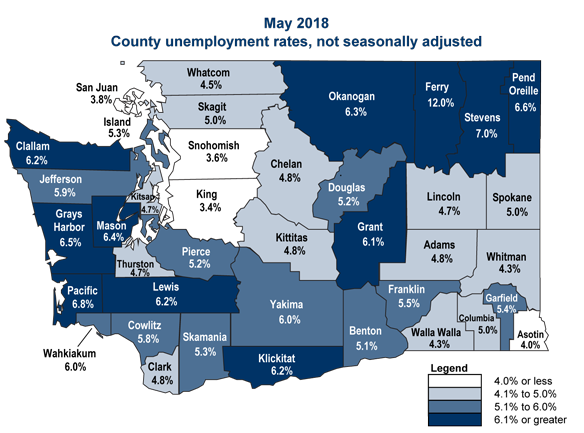
FOR IMMEDIATE RELEASE
CONTACT: CANDICE RUUD, 253.213.2960
TACOMA, Wash. – If you follow our website closely, you may have noticed WorkForce Central has recently published two notable Requests for Proposals (RFP): One for Dislocated Worker Program Career & Training Services, and the other for Adult Program Career & Training Services.
There’s a reason for that: We’re seeking to expand our capacity to serve unemployed and underemployed people in Pierce County, and grow our ability to connect them with job training and employers so they can earn a family wage locally.
While overall unemployment is down and many describe the current economy as a job seekers’ market, Pierce County’s unemployment rate is still stubbornly stuck above 5 percent.

May 2018 unemployment rates by Washington county. Source: Washington State Employment Security Department
In May, almost 22,000 Pierce County residents who are able to work were unemployed, according to the monthly employment report. That represents an unemployment rate of 5.2 percent – above the statewide rate of 4.7 percent, and well above the national unemployment rate of 4 percent.
Our unemployment rate is also higher than most of our neighbors, according to data from the Washington State Employment Security Department: King County’s unemployment rate in May was 3.4 percent. Thurston’s was 4.7 percent.
“Because we have such a higher unemployment rate than the U.S. and the state, we need to build capacity to be able to provide more services to more people,” said Linda Nguyen, CEO of WorkForce Central.
That means having the ability to serve more adults and dislocated workers – those who have recently been laid off or lost their job due to no fault of their own.
WorkForce Central currently contracts with ResCare to provide services to the business community and to youth and young adults, and contracts with Career Path Services to assist adults and dislocated workers.
WorkForce Central strengthens the Pierce County economy by identifying skill gaps between jobseekers and employment opportunities, fostering data-driven decision making, and connecting workforce development partners into a cohesive, collaborative and effective network.
###

